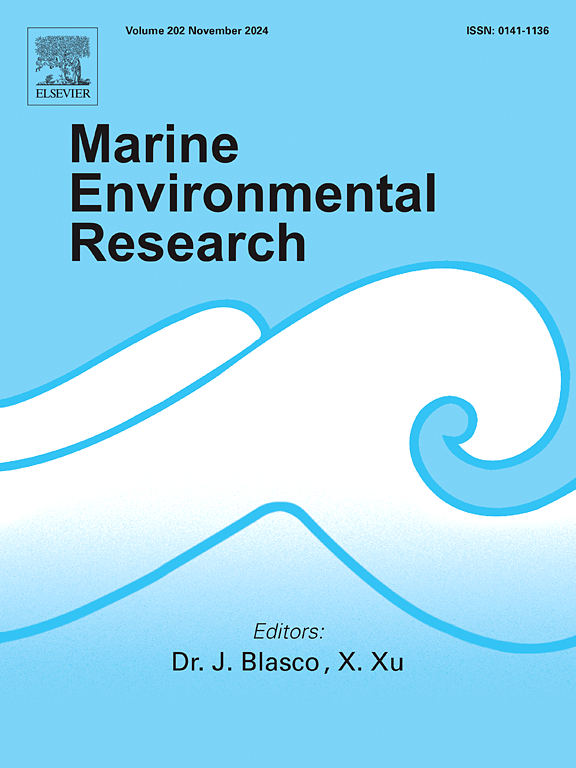硬核珊瑚对微量金属富集和热胁迫的生理响应
IF 3
3区 环境科学与生态学
Q2 ENVIRONMENTAL SCIENCES
引用次数: 0
摘要
由于全球气候变化和海洋污染,珊瑚白化事件日益频繁。微量金属,如锰(Mn)和铁(Fe),虽然高浓度有毒,但对珊瑚的生理至关重要,支持光合作用和抗氧化。本研究探讨了热应力和微量金属暴露如何相互作用影响硬核珊瑚Turbinaria irregularis和Montipora mollis的生理。珊瑚在控制温度(25°C)和升高温度(30°C)下暴露于不同浓度的锰和铁。Mn提高了光合效率,在250 nM下,M. mollis提高了1.7%,在30℃下,T. irregularis提高了1.4% (p <;0.05)。铁在50 nM下使M. mollis的光合作用提高1.8 %,在25℃下使T. irregularis的生长速率提高2.1 % (p <;0.05)。这两种金属都减轻了白化,如在相对灰色强度降低和共生藻密度增加中所见,特别是在中等浓度下。然而,升高的温度抑制了M. mollis (p <;0.01)。这些结果强调了微量金属在珊瑚健康和应激恢复中的关键作用,同时强调了微量金属吸收、热耐受性和生理反应的物种特异性差异的重要性。面对持续的气候变化,需要进一步的研究来阐明这些相互作用的机制和长期影响。本文章由计算机程序翻译,如有差异,请以英文原文为准。
Physiological responses of scleractinian coral to trace metal enrichment and thermal stress
Coral bleaching events are increasingly frequent due to global climate change and marine pollution. Trace metals, such as manganese (Mn) and iron (Fe), though toxic at high concentrations, are vital for coral physiology, supporting photosynthesis and antioxidation. This study investigates how thermal stress and trace metal exposure interact to influence the physiology of the scleractinian corals Turbinaria irregularis and Montipora mollis. Corals were exposed to Mn and Fe at varying concentrations under control (25 °C) and elevated (30 °C) temperatures. Mn enhanced photosynthetic efficiency, an increase of 1.7°% in M. mollis at 250 nM and 1.4°% in T. irregularis at 30 °C (p < 0.05). Fe improved photosynthesis by 1.8°% in M. mollis at 50 nM and growth rates by 2.1°% in T. irregularis at 25 °C (p < 0.05). Both metals mitigated bleaching, as seen in reduced relative gray intensity and increased symbiotic algal density, particularly at moderate concentrations. However, elevated temperatures suppressed growth and photosynthetic efficiency, with decreases up to 1.6°% in M. mollis (p < 0.01). These results highlight the pivotal role of trace metals in coral health and stress resilience, while emphasizing the importance of species-specific differences in trace metal uptake, thermal tolerance, and physiological responses. Further studies are necessary to elucidate the mechanisms and long-term impacts of these interactions in the face of ongoing climate change.
求助全文
通过发布文献求助,成功后即可免费获取论文全文。
去求助
来源期刊

Marine environmental research
环境科学-毒理学
CiteScore
5.90
自引率
3.00%
发文量
217
审稿时长
46 days
期刊介绍:
Marine Environmental Research publishes original research papers on chemical, physical, and biological interactions in the oceans and coastal waters. The journal serves as a forum for new information on biology, chemistry, and toxicology and syntheses that advance understanding of marine environmental processes.
Submission of multidisciplinary studies is encouraged. Studies that utilize experimental approaches to clarify the roles of anthropogenic and natural causes of changes in marine ecosystems are especially welcome, as are those studies that represent new developments of a theoretical or conceptual aspect of marine science. All papers published in this journal are reviewed by qualified peers prior to acceptance and publication. Examples of topics considered to be appropriate for the journal include, but are not limited to, the following:
– The extent, persistence, and consequences of change and the recovery from such change in natural marine systems
– The biochemical, physiological, and ecological consequences of contaminants to marine organisms and ecosystems
– The biogeochemistry of naturally occurring and anthropogenic substances
– Models that describe and predict the above processes
– Monitoring studies, to the extent that their results provide new information on functional processes
– Methodological papers describing improved quantitative techniques for the marine sciences.
 求助内容:
求助内容: 应助结果提醒方式:
应助结果提醒方式:


